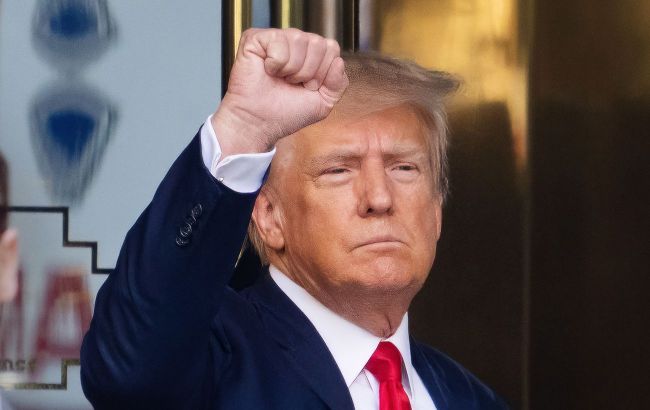Mass deportation: How Trump plans to deport millions of migrants from US
 Donald Trump (photo: Getty Images)
Donald Trump (photo: Getty Images)
Donald Trump plans a mass deportation of illegal immigrants from the United States, which could affect millions of people.
RBC-Ukraine explains why the immigration issue is so pressing in the US, what Trump intends to do, and where the deported illegals will be sent.
Contents:
- How many illegal immigrants are in the US
- What Trump plans
- Reactions from Mexico and other countries
Illegal immigration was one of the key issues during the US election campaign. Donald Trump criticized his opponents, initially Joe Biden and later Kamala Harris, for their failure to stop the flow of illegal immigrants into the US. He claimed that illegal immigrants take jobs away from Americans and worsen the crime situation. After coming to power, Trump seems determined to tackle the issue of illegal immigration in a tough manner.
How many illegal immigrants are in the US
A Gallup poll in June this year showed that 55% of Americans want to reduce immigration levels. This is the highest rate since 2001.
The US government does not publish data on the number of immigrants who enter the country illegally and remain there. However, US Customs and Border Protection tracks encounters with migrants attempting to cross the border illegally — numbers in the millions.
From October 2023 to September 2024, over 2.13 million “encounters” with migrants were recorded at the US-Mexico border. According to the US Department of Homeland Security, there are an estimated 11 million people living illegally in the US.
Southern states, particularly those bordering Mexico, he so-called Sun Belt, are most affected by the influx of illegal migrants.
What Trump plans
The new US president plans to take large-scale action on illegal immigration on his inauguration day, January 20. This is primarily about the “largest deportation operation in American history.”
"On my first day back in the Oval Office, I will sign a historic slate of executive orders to close our border to illegal aliens and stop the invasion of our country," Trump said on December 22 during a speech at the AmericaFest conference in Arizona.
According to Bloomberg, the plan's first phase involves deporting one million illegal immigrants. This will primarily focus on those who have committed crimes or have been issued a final order of removal after failing to gain asylum.
Thomas Homan, former acting head of Immigration and Customs Enforcement (ICE), will be in charge of the operation. Trump previously stated on his social media platform, Truth Social, that he plans to declare a state of emergency and involve the military to ensure the operation's effectiveness.
US law generally prohibits the use of armed forces for law enforcement purposes. However, the Trump administration plans to invoke the Insurrection Act, which was used during World War II to detain Italian, German, and Japanese immigrants. The last time it was used was by George H. W. Bush to suppress riots in Los Angeles in 1992.
Details on how the operation will unfold remain unclear. In an interview with CBS, Thomas Homan noted that one way to increase the number of personnel for the mass deportation plan would be to hire retired Border Patrol agents. According to him, private contractors could also help transport and set up facilities for detained migrants.
Trump's political opponents from the Democratic Party are already preparing to challenge the deportations. Attorneys general in several states where Democrats are in power are preparing lawsuits. These include efforts to contest Trump's attempts to deploy the military within the US.
However, 11 Democratic state governors interviewed by The New York Times have indicated a willingness to compromise. They are open to cooperating with the Trump administration to deport illegal immigrants who have been convicted of serious crimes. At the same time, the governors promised to protect migrant families, those fleeing violence in their home countries, and businesses reliant on migrant labor.
Reactions from Mexico and other countries
It won’t be enough to simply deport migrants outside the US. They will also need to be relocated to their countries of origin or a third country. The largest groups of illegal immigrants in the US come from Mexico and three small Central American countries: Honduras, Guatemala, and El Salvador.
According to Bloomberg, over the past decade, Mexico has accepted at least 1.7 million people. Officially, Mexico has stated that it is prepared to take back its citizens if they are deported from the US.
"In case there are deportations, we are going to receive Mexicans, and we have a plan for that," said Mexican President Claudia Sheinbaum on November 21.
At the same time, the Mexican government plans to present arguments to the Trump administration regarding the importance of having Mexicans in the US, including details about the taxes they pay.
El Salvador, where populist President Nayib Bukele is in power, has good relations with Trump’s team but has not shown much activity on the migrant issue. Nonetheless, a source close to discussions between Salvadoran officials and Trump’s transition team told Reuters that both countries are expected to actively cooperate on the matter.
There is another issue. The US cannot deport migrants from countries with which it has strained relations, such as Cuba, Venezuela, and Nicaragua.
According to Bloomberg, Trump has already discussed this problem with Mexico and El Salvador. His team has been communicating informally with the authorities of both countries to persuade them to accept some deported migrants from third countries, though no results have been achieved yet.
However, Guatemala is open to accepting citizens from other countries, Reuters reported, citing sources within the local government. The country’s government is willing to take this step to strengthen ties with Trump’s future administration.
In any case, Trump’s planned operation will be complex and prolonged, which could significantly divert his team’s focus from other priorities. This could be one reason why the new US president is eager to end the war between Russia and Ukraine as quickly as possible.
Sources: Donald Trump, Thomas Homan, and publications from the New York Post, Bloomberg, CBS News, Reuters, and The New York Times.

